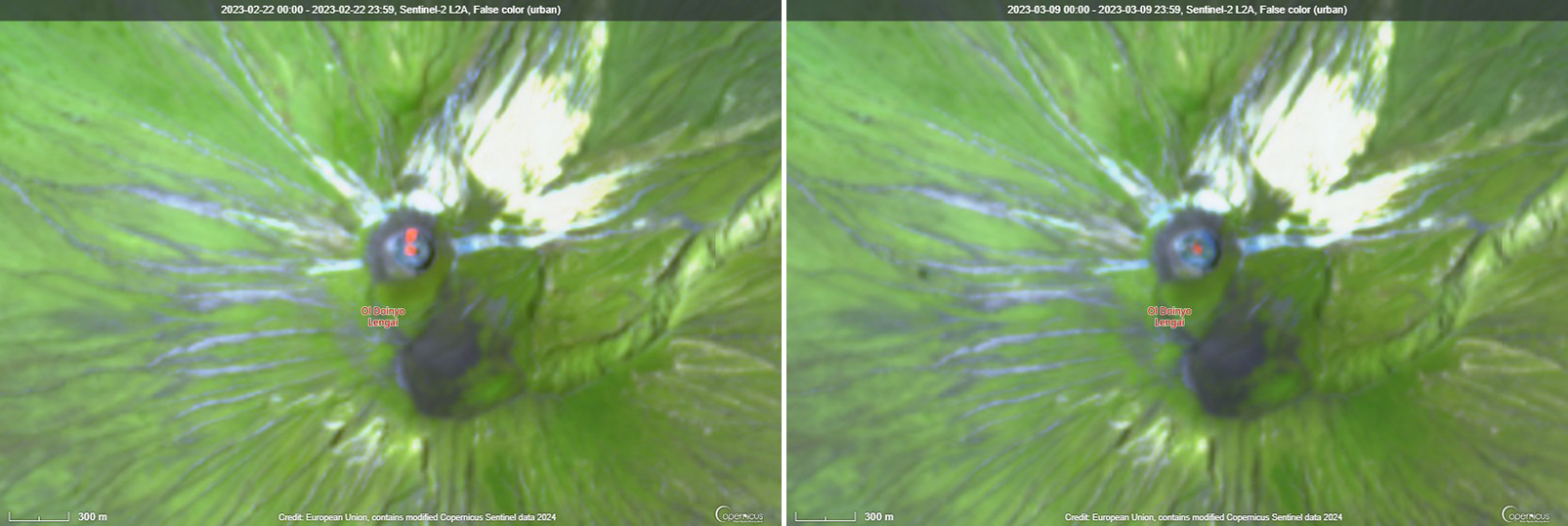Report on Ol Doinyo Lengai (Tanzania) — August 2023
Bulletin of the Global Volcanism Network, vol. 48, no. 8 (August 2023)
Managing Editor: Benjamin Andrews.
Edited by Kadie L. Bennis.
Ol Doinyo Lengai (Tanzania) Continued thermal activity at the summit crater during February-July 2023
Please cite this report as:
Global Volcanism Program, 2023. Report on Ol Doinyo Lengai (Tanzania) (Bennis, K.L., and Andrews, B., eds.). Bulletin of the Global Volcanism Network, 48:8. Smithsonian Institution.
Ol Doinyo Lengai
Tanzania
2.764°S, 35.914°E; summit elev. 2962 m
All times are local (unless otherwise noted)
Ol Doinyo Lengai, located near the southern end of the East African Rift in Tanzania, is known for its unique, low temperature, carbonatitic lava. Eruptions have been recorded since the late 19th century, characterized by smaller tephra ejections and numerous carbonatitic lava flows on the floor of the summit crater and occasionally on the upper flanks. Activity primarily occurs in the crater offset to the north about 100 m below the summit where hornitos (small cones) and a pit crater produce lava flows and spattering. The current eruption period began in April 2017 and recently has consisted of ongoing thermal activity in the summit crater (BGVN 48:03). This report covers similar activity during February through July 2023 using information primarily from satellite data.
Activity remained relatively low during this reporting period. The MIROVA (Middle InfraRed Observation of Volcanic Activity) volcano hotspot detection system, based on analysis of MODIS data, detected only a single thermal anomaly during early February, one during late May, one during late June, and five throughout July. On clear weather days, a persistent thermal anomaly was visible in infrared satellite imagery at the summit crater, which may have represented ongoing lava effusions from the central hornito (figure 222).
Thermal anomalies were visible in the center of the summit crater on 2, 12, 17, 22, and 27 February, 9 and 19 March, 13 April, 18 May, 12 and 27 June, and 2, 17, and 27 July. On 22 February two anomalies were visible: one in the center of the summit crater and one at the N end of the crater (figure 222). During 27 February, 9 and 19 March, and 13 April the strength of the central anomaly had decreased. On 18 May the strength and size of the anomaly increased slightly, and a small amount of cooling lava was visible to the NW of the hotspot (figure 223). On 12 June the anomaly grew, filling the middle of the summit crater and expanding slightly E and W (figure 223). On 27 June the anomaly migrated slightly to the E (figure 223). On 2 July two distinct anomalies filled the center of the summit crater. Cooling lava was visible in infrared imagery on 17 July to the NW, SE, and NE of the crater, which branched out from the middle anomaly (figure 223). A strong anomaly was captured in infrared imagery on 27 July that filled much of the S part of the crater and extended NE (figure 223).
Geological Summary. The symmetrical Ol Doinyo Lengai is the only volcano known to have erupted carbonatite tephras and lavas in historical time. The prominent stratovolcano, known to the Maasai as "The Mountain of God," rises abruptly above the broad plain south of Lake Natron in the Gregory Rift Valley. The cone-building stage ended about 15,000 years ago and was followed by periodic ejection of natrocarbonatitic and nephelinite tephra during the Holocene. Historical eruptions have consisted of smaller tephra ejections and emission of numerous natrocarbonatitic lava flows on the floor of the summit crater and occasionally down the upper flanks. The depth and morphology of the northern crater have changed dramatically during the course of historical eruptions, ranging from steep crater walls about 200 m deep in the mid-20th century to shallow platforms mostly filling the crater. Long-term lava effusion in the summit crater beginning in 1983 had by the turn of the century mostly filled the northern crater; by late 1998 lava had begun overflowing the crater rim.
Information Contacts: MIROVA (Middle InfraRed Observation of Volcanic Activity), a collaborative project between the Universities of Turin and Florence (Italy) supported by the Centre for Volcanic Risk of the Italian Civil Protection Department (URL: http://www.mirovaweb.it/); Copernicus Browser, Copernicus Data Space Ecosystem, European Space Agency (URL: https://dataspace.copernicus.eu/browser/).



